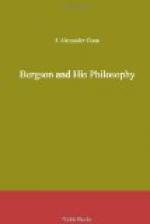We must conceive reality as a continual flux, then immobility will seem a superficial abstraction hypostatized into states, concepts, and substances, and the old difficulties raised by the ancients, in regard to the problem of Change, will vanish, along with the problems attached to the notion of “substance” in modern thought, because there is nothing substantial but Change. Apart from Change there is no reality. We shall see that all is movement, that we ourselves are movement—part of an elan, a poussee formidable, which carries with it all things and all creatures, and that in this eternity—not of immutability but of life and Change—“we live and move and have our being."[Footnote: La Perception du Changement, concluding paragraph, p. 37.]
CHAPTER III
PERCEPTION
Images as data—Nerves, afferent and efferent, cannot beget images, nor can the brain give rise to representations—All our perception relative to action. Denial of this involves the fallacies of Idealism or of Realism—Perception and knowledge—Physiological data—Zone of indetermination—“Pure” perception—Memory and Perception.
From the study of Change we are led on to a consideration of the problems connected with our perception of the external world, which has its roots in change. These problems have given rise to some very opposing views—the classic warfare between Realism and Idealism. Bergson is of neither school, but holds that they each rest on misconceptions, a wrong emphasis on certain facts. He invites us to follow him closely while he investigates the problems of Perception in his own way.
“We will assume for the moment that we know nothing of theories of matter and theories of spirit, nothing of the discussions as to the reality or ideality of the external world. Here I am in the presence of images, in the vaguest sense of the word, images perceived when my senses are opened to them, unperceived when they are closed. ... Now of these images there is one which is distinct from all the others, in that I do not know it only from without by perceptions, but from within by affections; it is my body."[Footnote: Matter and Memory, p. 1 (Fr. p. 1).] Further examination shows me that these affections “always interpose themselves between the excitations from without and the movement which I am about to execute."[Footnote: Matter and Memory, p. 1 (Fr. p. 1).] Indeed all seems to take place as if, in this aggregate of images which I call the universe, nothing really new could happen except through the medium of certain particular images, the type of which is furnished me by my body."[Footnote: Matter and Memory, p. 3 (Fr. p. 2).] Reference to physiology shows in the structure of human bodies afferent nerves which transmit a disturbance to nerve centres, and also efferent nerves which conduct from other centres movement to the periphery, thus setting in




